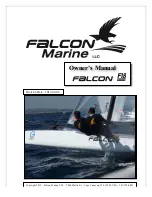
11
Vessel Operation
EMERGENCIES
Always be ready to help others on the water if possible,
but do not take any unnecessary risks. Use equipment to
save a life, but do not risk a life to save equipment. Consult
earlier information in this manual concerning accidents,
etc. Also, read other literature concerning on the water
emergencies. Be alert and prepared!
FIRE
Fire aboard a vessel can spread quickly and can cause
tremendous alarm among everyone. Most
fi
res can be
prevented by keeping the bilge free from oil and debris.
Keep all equipment stowed and maintained in working
order. Carry backup fire extinguishers on board. If
something becomes a possible
fi
re hazard, remove that
possibility at once.
Never use water on gasoline, oil or electrical
fi
res. When
you dump water on an electrical
fi
re you can be shocked
since water conducts electricity.
Follow these instructions if a
fi
re breaks out:
1. Fit everyone aboard with a life jacket. Turn off the
ignition switch.
2. Try to keep the
fi
re downwind. If the
fi
re is to the stern,
head the bow toward the wind. If forward, put the stern
to the wind.
3. If the engine should catch
fi
re, shut off the fuel supply
Usually there is a fuel tank access that you can crimp the
fuel feed line.
4. Use a hand fire extinguisher. Make sure to point
it at the base of the flames. Use short bursts and
sweep the extinguisher side to side.
Remember: (A 4
pound extinguisher discharges in approximately 20
seconds)
These actions help prevent the
fi
re from spreading to other
parts of the boat. You can extinguish
fi
res quickly if you
act swiftly. Have a plan of action in motion in case a
fi
re
breaks out.
FIRST AID
Knowing
fi
rst aid can save lives. A
fi
rst aid kit and the
ability to use it are important ingredients for the safety of
a skippers’ passengers, crew and vessel. Having con
fi
dence
and competence in handling medical emergencies on board
is a must for the skipper. Invest your time in a
fi
rst aid
course available at the American Red Cross.
If someone is seriously injured have someone call for help
while the injured person is being attended.
Check for possible danger signs; loss of breathing,
unconsciousness, severe bleeding and heartbeat. If you
determine the individual is not breathing or unconscious
place the victim on their back on a hard surface and do
the following:
1. If unconscious, open the airway. Neck lift, head lift or
chin head lift.
2. If not breathing, begin arti
fi
cial breathing. Pinch the
nose. Give 4 quick breaths. If airway is blocked, try back
blows, abdominal or chest thrusts and
fi
nger probe until
airway is open.
3. Check for pulse. Begin arti
fi
cial circulation. Depress
sternum. Fifteen compressions rate 80 per minute. 2 quick
breaths. Continue uninterrupted until advanced medical
support is available.
CPR (BASIC LIFE SUPPORT)
Summary of Contents for 38 EXPRESS
Page 1: ...784027 3 2013 OWNER S MANUAL 38 EXPRESS ...
Page 29: ...11 Safety On Board NAVIGATION LIGHT RULES ...
Page 50: ...9 Rules Of The Road ...
Page 51: ...10 Chapter 3 ...
Page 67: ...16 Chapter 4 TYPICAL MAIN DC PANEL METER SWITCH FUNCTIONS CO DC VOLTS ...
Page 109: ...58 Chapter 4 TYPICAL WASTE SYSTEM TOILET BOWL ASSEMBLY EARLIER MODELS ...
Page 142: ...14 Chapter 5 AFT FORWARD SIDEWAYS DIAGONALLY ROTATE TYPICAL JOYSTICK FUNCTIONS ...
Page 243: ...38 Chapter 8 ...
Page 275: ...15 Troubleshooting TYPICAL WINDLASS ...
Page 294: ...Technical Information 12 6 38 EXPRESS TYPICAL KOHLER GENERATOR W DIGITAL REMOTE WIRING ...
Page 295: ...Technical Information 12 7 38 EXPRESS TYPICAL DECK HARNESS 1 OF 2 ...
Page 296: ...Technical Information 12 8 38 TYPICAL DECK HARNESS 2 OF 2 ...
Page 297: ...Technical Information 12 9 38 EXPRESS TYPICAL SUMP MAIN DISTRIBUTION PANEL HARNESS ...
Page 298: ...Technical Information 12 10 38 EXPRESS TYPICAL SUMP DASH HARNESS ...
Page 299: ...Technical Information 12 11 38 EXPRESS TYPICAL SALON TV HARNESS ...
Page 300: ...Technical Information 12 12 38 EXPRESS TYPICAL STEREO HARNESS ...
Page 301: ...Technical Information 12 13 38 EXPRESS TYPICAL TRIM TAB SWITCH CIRCUITRY ...
Page 302: ...Technical Information 12 14 38 EXPRESS TYPICAL BATTERY SWITCH CIRCUITRY ...
Page 303: ...Technical Information 12 15 38 EXPRESS TYPICAL GFCI CIRCUITRY ...
Page 304: ...Technical Information 12 16 38 EXPRESS TYPICAL FIRE EXTINGUISHER GROUND CIRCUITRY ...
Page 305: ...Technical Information 12 17 38 EXPRESS TYPICAL TWIN VOLVO DIESEL ENGINE FIRE EXT SHUTDOWN ...
Page 306: ...Technical Information 12 18 38 EXPRESS TYPICAL BATTERY SWITCH CIRCUITRY ...
Page 307: ...Technical Information 12 19 38 EXPRESS TYPICAL FIREWALL WIRING ...
Page 308: ...Technical Information 12 20 38 EXPRESS TYPICAL WIPER CIRCUITRY OVERVIEW ...
Page 309: ...Technical Information 12 21 38 EXPRESS TYPICAL FUSION INSTALLATION ...
Page 310: ...Technical Information 12 22 38 EXPRESS TYPICAL FUSION SUB WOOFER INSTALLATION ...
Page 311: ...Technical Information 12 23 38 EXPRESS TYPICAL FUSION ZONES ...
Page 312: ...Technical Information 12 24 38 EXPRESS TYPICAL AIR CONDITIONING INSTALLATION ...
Page 313: ...Technical Information 12 25 38 EXPRESS TYPICAL HARDTOP INSTALLATION ...
Page 314: ...Technical Information 12 26 38 EXPRESS TYPICAL SUMP LAYOUT ...
Page 315: ...Technical Information 12 27 38 EXPRESS TYPICAL PLUMBING LAYOUT ...
Page 317: ...Technical Information 12 29 38 EXPRESS TYPICAL SLING LOCATIONS ...
















































